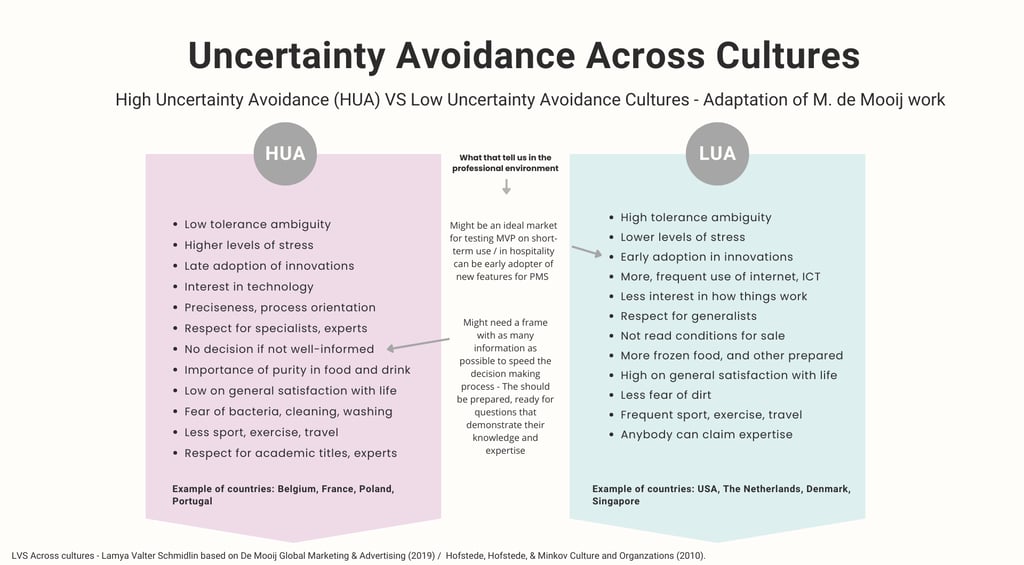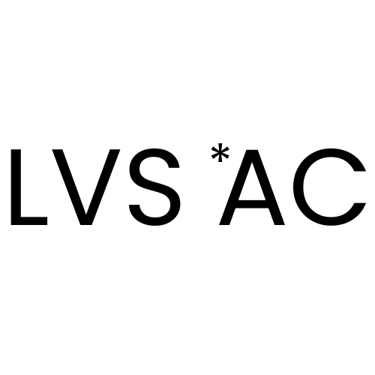Mind the Gap: Understanding Uncertainty Avoidance Across Borders
France, Belgium, and the Netherlands differ significantly in how they approach uncertainty and ambiguity. These differences influence attitudes toward rules, decision-making, and the adoption of new concepts, all of which have direct implications in professional environement. This article combines cultural theory (Hofstede’s 6D Model) with insights from M. de Mooij’s work on global marketing. With practical examples to explore how uncertainty avoidance shapes brand consistency, talent experience, and product development. and a comparison table offer clear takeaways for cross-border collaboration. The goal: turning cultural contrasts into strategic advantages in international settings.
INTERCULTURALCROSS-CULTURAL MANAGEMENTCROSS-CULTURALHUMAN RESSOURCES
Lamya Valter Schmidlin
10/19/20254 min read
What’s fascinating is how even geographically close countries can differ widely in this regard. For instance, Belgium and the Netherlands score very differently. Belgium, has a higher uncertainty avoidance score than France. This leads to noticeable differences in how rules are followed, how change is embraced, and how comfortable people are with ambiguity, even across a short train ride.
So how this translate into concrete work collaboration between both cultures? Thinking about a French or Belgian company that opens a local Dutch office, there should be challenges between perspectives. Below are some examples mentioning the adoption of brand guidelines, talent experience and in ptoduct development.
How uncertainty avoidance affects cross-cultural collaboration?
Belgium (94) & France (86) | Netherlands (53)
1. Adoption of Brand Standards/Guidelines in Marketing
Cultures: France & Belgium
Approach: a preference for structured brand communication. Brand guidelines are carefully followed allowing maintaining consistency, protecting brand reputation, and reflecting professionalism. Campaigns often go through experts with recognized credentials, ensuring strategic alignment
Culture: Netherlands
Approach: a more flexible and adaptive approach to branding. Guidelines are treated as a helpful framework rather than rigid rules. There is greater comfort with local adaptations and creative risk-taking. Emphasis is often on practical experience and testing ideas in-market.
Collaboration touchpoints:
Dutch teams may suggest playful or experimental campaigns that creatively stretch brand standards to better connect with local audiences. French or Belgian colleagues may prefer to consult the branding specialists before trying the in-market ideas. Collaborative ideas:
Pilot the campaign on a small scale in the Dutch market to assess impact while managing risk
Document key learnings to inform brand evolution
Keep open dialogue between "creative leads" and "brand guardians" to balance local resonance with global brand coherence
2. Talent Experience
Cultures: France & Belgium
Approach: professionals will tend to prefer clear job roles, structured onboarding, and more formal training. Qualifications and recognized diplomas are often seen as essential for career progression and service excellence.
Culture: Netherlands
Approach: the workplace culture tends to be more informal and flexible, with an emphasis on autonomy. Employees often thrive in multifunctional roles and may learn best through hands-on experience rather than formal instruction.
Collaboration Touchpoint:
In cross-border hospitality teams, French or Belgian managers may emphasize procedure and role expertise, while Dutch colleagues may prioritize adaptability and flat hierarchies. Open dialogue about what "professionalism" looks like in different cultures can help build mutual respect and effective teamwork.
3. Development of a new product - restaurant
French or Belgian partners may say: “We need a feasibility study and branding validation before moving forward.” while Dutch teams may say: “Let’s just test the idea in a small space next month and learn from it.”
Culture: France & Belgium
Approach: the process is structured and might take + time to minimize risk and ensure long-term success. Decisions are frequently supported by specialists with industry credentials.
Culture: The Netherlands
Approach: there's often a willingness to experiment with new concepts quickly, using lean or informal pilots to test the market. The emphasis is on agility, iteration, and learning by doing, without always waiting for formal studies. However, the process can also take time but not for the same reason -> Dutch work with a collaborative approach and with consencus which may delay if there as there is no guidance from a vertical hierarchy. (see this article about hierarchy in Fr vs Nthrlds).
Collaboration Touchpoint:
Combining structured planning with pro-active experimentation can result in both innovative and sustainable outcomes. this could be done through agile market testing (Netherlands) while running parallel tracks with expert validation/risk planning in Belgium/France.
--
By recognizing these cultural patterns and designing collaboration touchpoints that respect both structured planning and creative agility, cross-cultural teams can achieve outcomes that are both locally relevant and globally consistent. Nobody said it was easy! :) These differences can lead to friction, but also to powerful synergy when approached with openness and curiosity.
The articles/books I've read to write this article:
Verwaal, E., Pastwa, A. M., & Reis Neto, M. T. (2024). Environmental uncertainty and entrepreneurial orientation in collectivist and individualist cultures: Evidence from Brazil and Belgium.
Hofstede, G., Hofstede, G. J., & Minkov, M. (2010). Cultures and Organizations: Software of the Mind (3rd ed.). McGraw-Hill.
de Mooij, M. (2019). Global Marketing and Advertising: Understanding Cultural Paradoxes (5th ed.). SAGE Publications.
Thank you for reading!
Lamya
One of the biggest cultural differences I’ve noticed here, as a French person in the Netherlands, is how differently people react to uncertainty and ambiguity and how they handle these situations. Which can be reflected in how we relate to rules or adopt new things.
We, the French, such as in Belgium and Poland, tend to score very high on the uncertainty avoidance scale (Hofstede, 6D Model). This shows in our need for rules and formality to structure life, and in our trust in so-called “experts.” It can sometimes lead to intolerance or low trust in others, and from the perspective of cultures on the opposite end of the scale, it can be seen as rigidity or inflexibility.
In countries that score low on the uncertainty avoidance index like in the Netherlands, USA or Singapore, the general feeling is that there should be as few rules as possible. People in these cultures tend to be more results-oriented than process-oriented -> if there are rules, it is often seen as enabling freedom and efficiency, not limiting it.
According to M. de Mooij, Global Marketing & Advertising (2019): "In high uncertainty avoidance cultures, someone called an "expert" must truly be an expert, typically with degrees and proven specialization to justify the title. This contrasts with countries like the United States, which score lower on the scale, where anyone can call themselves an expert, simply because there is no formal definition of what an expert must know or be."


LVS *AC
Cross-cultural guest experience research
contact
lamya@lvsacrosscultures.com
+33 782 353 314
© 2024. LVS AC - All rights reserved.
